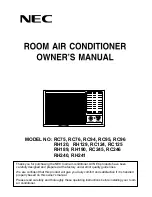
En-8
6.2. Selecting circuit breaker and wiring
CAUTION
Be sure to install a breaker of the specified capacity.
Regulation of cables and breaker differs from each locality, refer in accordance with
local rules.
Breaker and wiring specifications
Breaker
capacity
[A]
Earth leakage
breaker
[mA]
Power supply cable
Transmission cable
*
Conductor size
[mm²]
Conductor size
[mm²]
Max. length
[m]
30
30
3.5
2.5
50
Selected sample: Select the correct cable type and size according to the country or
•
region’s regulations.
Max. wire length: Set a length so that the voltage drop is less than 2%. Increase the
•
wire diameter when the wire length is long.
Select the appropriate breaker of the described specification according to the national
•
or regional standards.
Select the breaker that enough load current can pass through it.
•
Before starting work check that power is not being supplied to all poles of the indoor
•
unit and outdoor unit.
Install all electrical works in accordance to standard.
•
Install the disconnect device with a contact gap of at least 3mm in all poles nearby
•
the units. (Both indoor unit and outdoor unit)
Wiring size must comply with the applicable local and national code.
•
6.3. Wiring method
6.3.1. Connection diagrams
N
L
3
1
3
2
2
1
Power supply
Outdoor unit
side terminal
Indoor unit
side terminal
Power line
EARTH
EARTH
6.3.2. Connection cable preparation
Keep the earth wire longer than the other wires.
•
Earth wire
30 mm
Power supply cable or
Transmission cable
35 mm
CAUTION
The primary power supply capacity is for the air conditioner itself, and does not
include the concurrent use of other devices.
Do not use crossover power supply wiring for the outdoor unit.
If the electrical power is inadequate, contact your electric power company.
Install a breaker in a location that is not exposed to high temperatures.
If the temperature surrounding the breaker is too high, the amperage at which the
breaker cuts out may decrease.
When using an earth leakage breaker that has been designed solely for ground fault
protection, be sure to install a fuse-equipped switch or circuit breaker.
This system uses an inverter, which means that it must be used an earth leakage
breaker that can handle harmonics in order to prevent malfunctioning of the earth
leakage breaker itself.
Do not connect the AC power supply to the transmission line terminal board. Improper
wiring can damage the entire system.
Do not use crossover power supply wiring for the outdoor unit.
If the temperature surrounding the breaker is too high, the amperage at which the
breaker cuts out may decrease.
When the electrical switchboard is installed outdoors, place it under lock and key so
that it is not easily accessible.
Start wiring work after closing branch switch and over current breaker.
Transmission cable between indoor unit and outdoor unit is 230 V.
Be sure not to remove thermistor sensor etc. from power wiring and connection
wiring. Compressor may fail if operated while removed.
Do not fasten the power supply cable and connection cable together.
Always keep to the maximum length of the connection cable. Exceeding the maximum
length may lead to erroneous operation.
Do not start operation until the refrigerant is charged completely. The compressor will
fail if it is operated before the refrigerant piping charging is complete.
The static electricity that is charged to the human body can damage the control PC
Board when handling the control PC Board for address setting, etc.
Please keep caution to the following points.
Provide the grounding of Indoor unit, Outdoor unit and Option equipment.
Cut off the power supply (breaker).
Touch the metal section (such as the unpainted control box section) of the indoor or
outdoor unit for more than 10 seconds. Discharge the static electricity in your body.
Never touch the component terminal or pattern on the PC Board.
How to connect wiring to the terminal
Caution when wiring cable
When stripping off the coating of a lead wire, always use a special tool such as a wire
•
stripper. If there is no special tool available, carefully strip the coating with a knife etc.
(1) Use crimp-type terminals with insulating sleeves as shown in the figure below to
connect to the terminal block.
(2) Securely clamp the crimp-type terminals to the wires using an appropriate tool so
that the wires do not come loose.
Sleeve
Strip : 10 mm
Crimp-type
terminal
(3) Use the specified wires, connect them securely, and fasten them so that there is no
stress placed on the terminals.
(4) Use an appropriate screwdriver to tighten the terminal screws. Do not use a
screwdriver that is too small, otherwise, the screw heads may be damaged and
prevent the screws from being properly tightened.
(5) Do not tighten the terminal screws too much, otherwise, the screws may break.
Wire
Screw with special washer
Crimp-type terminal
Terminal blocks
Screw with
special washer
Wire
Crimp-type
terminal
(6) See the table below for the terminal screw tightening torques.
Tightening torque [N·m (kgf·cm)]
M4 screw
1.2 to 1.8 (12 to 18)
M5 screw
2.0 to 3.0 (20 to 30)
9374995295_IM.indb 8
22/1/2556 16:12:22





























